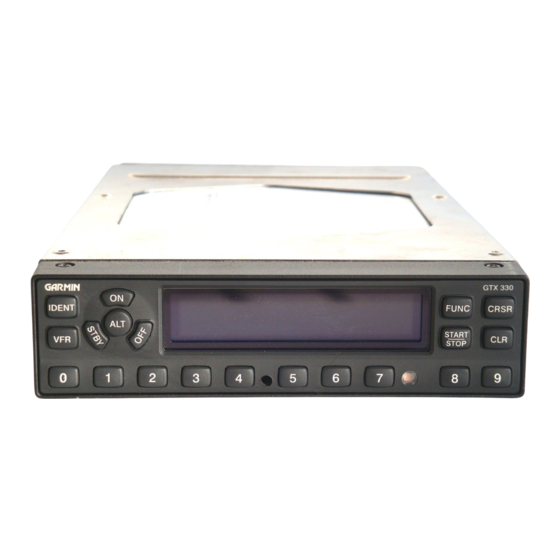- ページ 33
海上ラジオ Garmin GTX GTX 330DのPDF パイロット・マニュアル補遺をオンラインで閲覧またはダウンロードできます。Garmin GTX GTX 330D 50 ページ。 Mode s transponder
Garmin GTX GTX 330D にも: パイロット・マニュアル補遺 (50 ページ), パイロット・マニュアル (13 ページ), パイロット・マニュアル (13 ページ), インストレーション・マニュアル (49 ページ)

Section 2: TAWS Operation
TAWS (Terrain Awareness and Warning System)
is an optional feature to increase situational aware-
ness and aid in reducing controlled flight into terrain
(CFIT). TAWS satisfies TSO-C151b Class B require-
ments for certification. Class B TAWS is required for
all Part 91 aircraft operations with six or more passen-
ger seats and for Part 135 turbine aircraft operations
with six to nine passenger seats (FAR Parts 91.223,
135.154).
TAWS provides visual and aural annunciations
when terrain and obstacles are within the given alti-
tude threshold from the aircraft.
Requirements
TAWS requires the following to operate
properly:
• The system must have a valid 3-D GPS position
solution.
• The system must have a valid terrain/obstacle/
airport terrain database.
Limitations
NOTE: The data contained in the TAWS databases
comes from government agencies. Garmin accurately
processes and cross-validates the data but cannot
guarantee the accuracy and completeness of the data.
TAWS displays terrain and obstructions relative
to the altitude of the aircraft. The displayed alerts
and warnings are advisory in nature only. Individual
obstructions may be shown if available in the database.
However, all obstructions may not be available in the
database and data may be inaccurate. Never use this
information for navigation or to maneuver to avoid
obstacles.
Terrain information is based on terrain elevation
information in a database that may contain inaccura-
cies. Terrain information should be used as an aid to
situational awareness. Never use it for navigation or to
maneuver to avoid terrain.
TAWS uses terrain and obstacle information sup-
plied by government sources. The data undergoes veri-
fication by Garmin to confirm accuracy of the content,
per TSO-C151b. However, the displayed information
should never be understood as being all-inclusive.
TAWS Alerting Using the GPS Position/GPS-MSL
Altitude
TAWS uses information provided from the GPS
receiver to provide a horizontal position and altitude.
GPS altitude is derived from satellite measurements.
GPS altitude is converted to a mean sea level (MSL)-
based altitude (GPS-MSL altitude) and is used to
determine TAWS alerts. GPS-MSL altitude accuracy is
affected by factors such as satellite geometry, but it is
not subject to variations in pressure and temperature
that normally affect pressure altitude devices. GPS-
MSL altitude does not require local altimeter settings
to determine MSL altitude. Therefore, GPS altitude
provides a highly accurate and reliable MSL altitude
source to calculate terrain and obstacle alerts.
Baro-Corrected Altitude Versus GPS-MSL Altitude
Baro-corrected altitude (or indicated altitude) is
derived by adjusting the altimeter setting for local
atmospheric conditions. The most accurate baro-cor-
rected altitude can be achieved by frequently updating
the altimeter setting to the nearest reporting station
along the flight path. However, because actual atmo-
sphere conditions seldom match the standard condi-
tions defined by the International Standard Atmo-
sphere (ISA) model (where pressure, temperature, and
Part Three: Section 2
TAWS Operation
29
